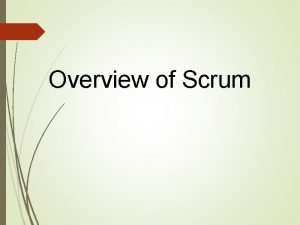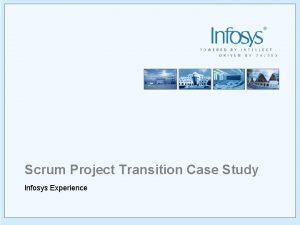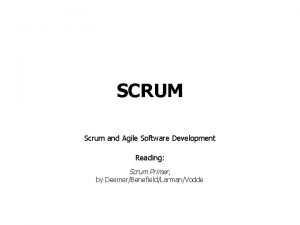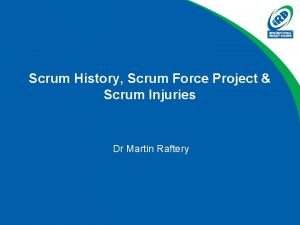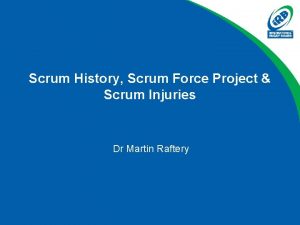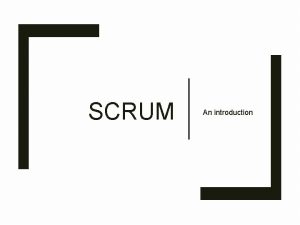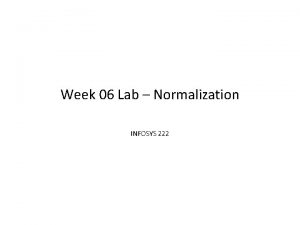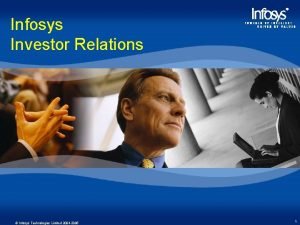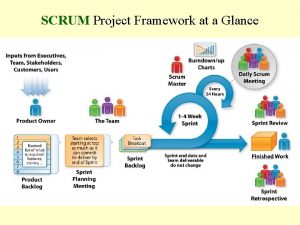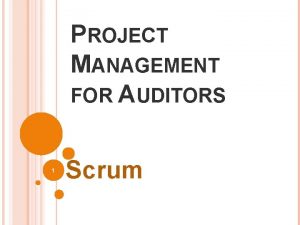Scrum Project Transition Case Study Infosys Experience Agenda










- Slides: 10

Scrum Project Transition Case Study Infosys Experience

Agenda n Client Overview n Transition Project Overview n A brief introduction to Scrum n Transition Approach n Deliverables and Exit criteria n Critical Success Factors 2

Client Overview n The client is one of the largest Telecom services provider in United Kingdom, providing: l Fixed line services l Mobile services l Cable and broadband services l Directory Services l Internet and e-commerce services 3

Transition Project Overview n Scope of Project l Transitioning knowledge on Development / Enhancement and Application Support and Maintenance services for 10 application modules from the client l Provide complete range of Development / Enhancement and Application Support and maintenance services to the client for these applications l Application owners are distributed all over the world. n Time frame l Approximately 2 weeks to 1 month for all the modules. n Technologies Involved l VB, ASP and C#. NET l Oracle 9 i 4

A brief introduction to Scrum n Scrum is one of the Agile methodologies championed by Ken Schwaber. n The salient features of Scrum as followed by the client are; l 30 day development cycle known as SPRINT. l Minimal or no documentation. l Requirements in the form of features being put into RALLY a third party tool available on the internet. l Requirements are broken into story cards to be developed and delivered over one or more sprints. l A set of story cards are finalised as deliverables at the end of a 30 day sprint in consultation with the application owners during a 2 day planning meeting. l Finer details of the story cards are discussed by the developer with the application owners during the initial days of the sprint. Also, developers are constantly interacting with the application owners for demonstrations of user screens developed by them. l Developer designs and implements the story cards and demonstrates the functionality to the application owners on the development machine. l Once, application owner gives his go ahead, the story card is deployed on UAT where some of the users test the functionality and accept the deliverables. l Scrum master is responsible to tracking of the monthly sprint. l 15 minutes daily scrum meeting where team members update on their previous, current tasks and raise any issues which are stopping them. 5

Transition Approach n Scrum master for the project travelled onsite to take training from the client project manager who is a certified scrum master. n He interacted very closely with the client scrum master to study the finer intricacies of scrum process implementation. n For most of the modules a lead developer travelled onsite to interact closely with the client lead and acquire knowledge about the application. This phase lasted for a month. n This knowledge was shared with their offshore counterparts via daily telecons. n The offshore counterparts meanwhile worked on the system appreciation documents. n The offshore – onsite connectivity issues were resolved in this timeframe. n The confidence of the client was acquired by delivering a few story cards from onsite during the first month of knowledge transfer. n During the second month most of the modules were transitioned and scrum master and rest of the onsite members returned offshore. n Most of the second sprint was developed and delivered from offshore. 6

Deliverables and Exit criteria l System Appreciation Presentation for each of the roles – A presentation that reflects Infosys’s understanding of the acquired knowledge on all the above mentioned areas and roles. This was prepared for most of the modules offshore and a session was arranged with the client to give a presentation of their understanding of the systems. l Reverse Knowledge Transfer Sessions – Infosys conducted Reverse KT workshops for all application areas with key members from the Client team and Incumbent vendor’s team. Objective was to present Infosys’s understanding of the application and processes l Application Inventory Document – This document contained a comprehensive list of Software (Tools, OS and licenses), Hardware (Configuration, layout) and Application (Components) being used in the Production and Production Support environments l Delivery for month 1 sprint from onsite – The leads who has travelled onsite delivered some of the deliverables successfully from client site. l Delivery for month 2 sprint from offshore – The sprint for the second month was entirely delivered from offshore. 7

Critical Success Factors n Client Involvement l The client project manager was a certified scrum master and his assistance was sought in training the Infosys scrum master. n Reverse presentation Sessions l Infosys provided Reverse presentation sessions from offshore to the incumbent team and the Client to validate their understanding of the application l This was also a major ‘’Confidence Building” exercise for the client to get a first hand feel of Infosys’s understanding of the application offshore. n Establish a GDM model for scrum implementation. l Scrum requires that the entire team works very closely and interacts frequently. l Video conferencing facilitated effective sprint planning meetings in the GDM model. l Daily scrum calls were organised via telecon between onsite and offshore and application owners distributed all over the world. l Weekly calls were setup between application owners and Infosys leads, delivery manager and scrum master to track the progress of the sprint. 8

Critical Success Factors …contd n Successful delivery of two sprints l Infosys provided the delivery of first sprint from onsite and second from offshore successfully. l This was also a major ‘Confidence Building” exercise for the client to ensure that the GDM model of Scrum delivery provided by Infosys works. n Establish Clear Accountabilities l Key Infosys resources were identified as “leads” of respective applications l It was their accountability to ensure complete coverage of knowedge transition in their applications with assistance from other team members 9

Thank You
